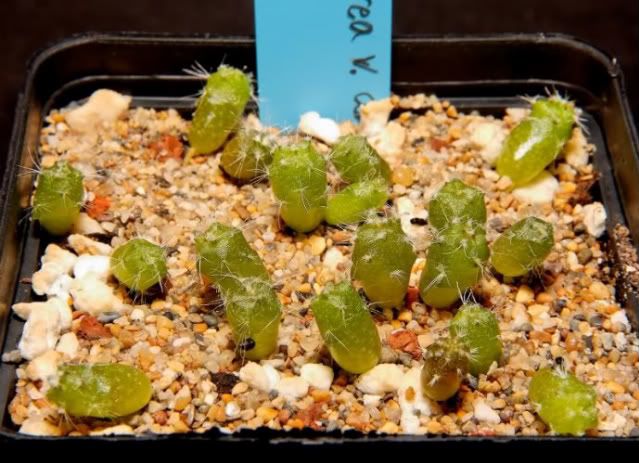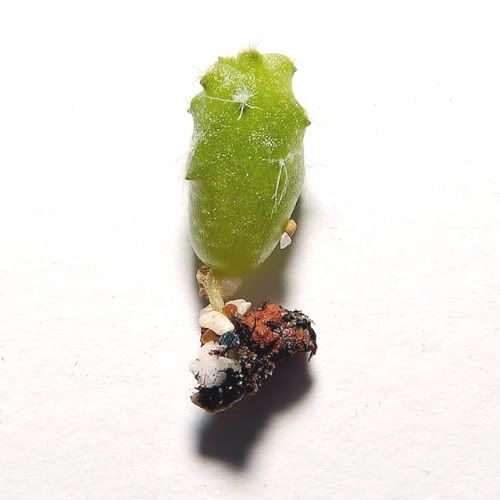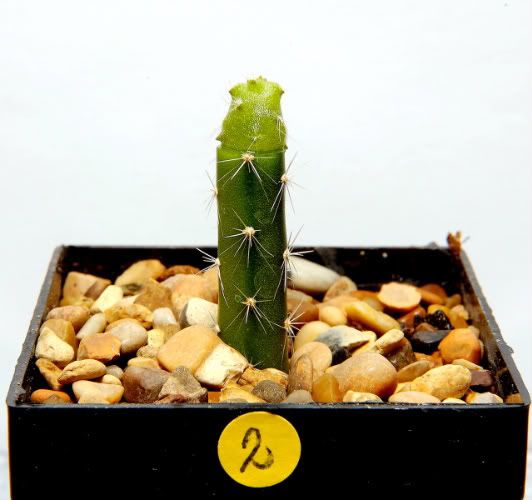|
Recent Entries to this Blog
How to graft cactus seedlings - one result
Posted: 29 Oct 2010 Posted: 29 Oct 2010 Posted: 24 Oct 2009 Posted: 04 Sep 2009 Posted: 11 Oct 2009 All Entries |
How to graft cactus seedlingsThere are many different ways to graft a cactus seedling, but I will show how I have done it. First of all you have to choose what grafting stock you want to use. There are many that are suitable for this, and to mention some: Opuntia humifusa, Myrtillocactus geometrizans, Pereskiopsis, Trichocereus, Hylocereus and Selenicereus. All of them works but give some different result on different species. Some of them are suitable for permanent grafting and are very hardy, but can give an unnatural growing shape; bloated. Others will not live very long, but push the graft in a natural way. I choose Selenicereus grandiflorus for two reasons. First it is proven to make a normal growing form on the species I want to graft. Second, I have a big plant that I can get cuttings from. Step one First you have to decide what species you want to grow and get some seeds. I am growing a lot of Chilean cacti at the moment; Copiapoa and Eriosyce. Earlier this year I ordered a lot of different seeds from a dealer here in Sweden; SuccSeed. The one I choose for this example is Copiapoa dealbata FK56. The seed was originally collected by Fred (Friedrich) Kattermann, a German author, botanist and collector, now living in USA. And the seeds were collected from plants located 10 km South of Carrizal Bajo, Huasco, Chile, at the altitude of 40 meters above sea level. 
This is an extremely slow growing cactus. Many collectors want it and big plant is very expensive. Many keep it for the beauty of its form. Step two You have to sow the seeds and take a cutting for the stock. It's easier if you make sure the stock is rooted and growing before you graft. The right time to make a graft is the time when the stock is growing; spring and summer. The seeds was sown 2009-04-18, and they where only 3 month old when I picked out some seedling to graft. 
Step three Time to graft! Make sure you have water the stock the previous day so it's not thirsty. You need a clean sharp knife. I use a paperknife and make it sterile in boiling water. Then you need a sterile place where you can cut the seedling. A clean cut of the stock. 
The little ring in the middle of the stock is the vascular part and it has to make contact with the same little ring on the scion (graft). It's hard to tell where it is on a small seedling, but it is in the center of the plant. 
Make sure you press gently on top of the graft to remove all air bubbles and make an all over contact. If the seedling is small it will glue it self to the stock. Finish! Now you have to make sure it will not dry out, and I put mine under a transparent jar turned up side down. To make sure that the humidity not drop to low or rise to high I put a digital meter inside. For me it works fine with humidity between 70 and 80%. I store the jar in a light place. No direct sun light. Room temperature is preferred. It remains in that environment for two weeks, and then you drop the humidity day by day. Then it can take some sunlight, in partly shadow. I put mine in a window with morning light. 
To be continued... (I will show the growing graft in different ages) Last edited: Wed Oct 21, 2009 12:18 pm This blog entry has been viewed 2014 times
You're reading one of many blogs on GardenStew.com.
Register for free and start your own blog today.
Great photos, great tutorial. Thanks Christer. Looking forward to updates.
Thanks.
Are you kidding? Your English is great!
great work, Christer. Congrats. and keep growing
Login or register to leave a comment. |
|

